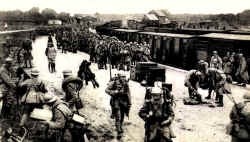 |
| French troops detraining on their way to the Verdun
front |
 The first German attack: the occupation of Fleury The first German attack: the occupation of Fleury
The next big offensive is
aimed at the occupation of the village of Fleury and the conquering of Fort
Souville. From there the German army intends to march on to Verdun.
Before the big attack takes place the three German divisions, which are
situated between Côte du Poivre and Fort Douaumont, have to strengthen
their point of departure and take the Thiaumont-fortification. This is a
small fort with an armoured turret that accounts for a lot of the damage
done to the German troops from its mighty position on the hillcrest.
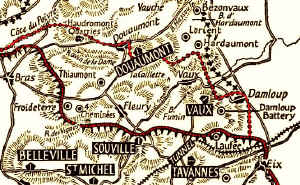 |
| The battlefield between 26 February and 12 July 1916 |
Thursday - 8 June The attack starts but is warded off. The next
attacks on Monday 12 and Tuesday 13 June were only partly successful: a
number of French fortifications and machine-gun posts are taken in this
area. The Thiaumont fortification, however, is still in French hands.
Wednesday - 21 June 3:50 p.m. Three army corps, existing of 6
divisions with a total of 60,000 men come into action in order to prepare
for the planned attack that will take place two days later. The
preliminary bombardment causes less damage than expected but it served as
a warning to the French with regard to the next attack. The French
surrender at some places but in most cases the Germans are awaited by
machine-gun fire. Sharpshooters try to eliminate the German officers, as
is common with these kinds of attack. This attack is not successful
either. Only at the left wing, between Fort Vaux and Fort Tavannes, the
French fortifications are taken.
(Note: later the officers can no longer be distinguished from the
soldiers. Also at the battle of the Somme the German sharpshooters receive
the order to shoot at English officers, who can be recognised by their
sword belts and their high leather boots).
This last attack is the first step towards the big offensive on 23 June, a
scorching hot summer day. During this attack a new kind of poisonous gas
is used for the first time. It is phosfine gas, which is lethal, but not
for a couple of days and under the most horrible circumstances. It is
expected that the French gas masks will not be able to withstand this new
poisonous gas. On Thursday 22 June, at 10:00 P.M. the signal is given and
230 guns shoot 110,000 poisonous gas grenades. The French guns fall silent
one by one; the poisonous gas seems to be working.
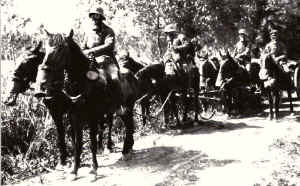 |
| Men and horses wearing gasmasks
during the gas attacks |
Friday - 23 June at 6:00 a.m. The attack starts; the gas has
silenced the battery of guns in the hinterland but the front French lines,
barely suffered from the gas attack. The German attack stagnates at an
early stage. The attack of Fort Souville fails completely. Only in the
centre of the attack successes are reported: the Thiaumont fortification
is taken and Fleury is partly occupied. The village now has an important
position in the German frontline.
At 9:00 a.m. the French artillery revives. They aim their fire, following
the Germans example, at the village of Fleury where the Germans and French
are involved in man-to-man fights for every inch of land. In the meantime
the fortification of Froideterre is taken as well and the French command
post in Quatre Cheminees is besieged and captured. At the end of the
afternoon the battle diminishes. The heat and thirst take their toll; the
troops become exhausted and lack water and ammunition. The German army
commanders are disappointed: the attack at Verdun has failed again.
|
A French soldier: …and during the summer months the swarms of flies
around the corpses and the stench, that horrible stench.
If we had to
construct trenches we put garlic cloves in our nostrils... |
|
 The crises in the French defence
The crises in the French defence
By now the French defence has manoeuvred itself into a crisis
situation. French troops are panicking and fleeing through the streets of
Verdun. Defence trenches are already being constructed in the city.
Soldiers who are poisoned with gas can be seen everywhere. They lie on the
ground screaming and suffer immensely. In a moment of panic they start
with the evacuation of army units and supplies. The army commanders offer
no co-ordination whatsoever and no one has any insight in the situation.
In this period it is even considered, by Pétain and Nivelle as well, to
vacate the right riverbank of the Muese. Pétain used as a motive for this
that the Germans, if a breakthrough would occur, would gain power over a
large part of the entire French artillery. This would mean a considerable
setback for the fighting strength of the French army.
Nevertheless they are afraid to take the risk because of the influence
that the evacuation might have on the morale of the French people. The
supreme command would be accused of the fact that the immense losses have
been pointless and that surrendering Verdun will be considered a failure
for the entire French nation. (Note: the same argument is used at
German side!)
Allegedly there even is a crisis situation at the Headquarters and Joffre
and De Castelnau are supposed to be at a complete loss. That night Joffre
even promises to send four new divisions, in spite of the fact that these
troops are essential in the upcoming offensive at the Somme front. Mangin,
who was dismissed, is called back.
The fact that the Germans are not able to force a breakthrough is due
to individual actions of French officers who individually organise the
defence at the front. And to the French artillery that carries on with the
barrage which causes the Germans to be stuck in their fortifications.
Saturday - 24 June The headquarters of the Vth
army
receive the request to be more economical with men, materials and ammunition.
The German supreme Command expects a large allied attack in the Somme area
and a large Russian offensive at the eastern front, which has started on
Sunday 4 June, demands all attention as well.
Von Knobelsdorf wants to launch a very last attack on Verdun. Ceasing
the attacks would mean that the German troops have to retreat because the
terrain that is conquered so far, is extremely difficult to defend. The
question remains how the terrible sacrifices will ever be justifiable if
the conquered area is given up voluntarily?
Sunday - 25 June The French, after a brief preliminary
bombardment, launch an unexpected counterattack, in which the Thiaumont-fortification is almost taken. In the following days the French army keeps
on attacking, which is the reason the German preparations for the planned
attack have to be postponed.
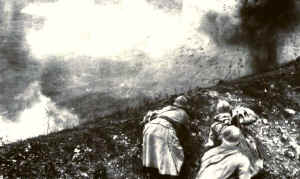 |
| French attack on the
Thiaumont-fortification |
Saturday - 1 July The Battle of the Somme begins. Troops,
artillery and aeroplanes are transferred from the Verdun front to the
Somme front. The Verdun front is in danger of becoming less important.
This does not mean the battle has become less fierce. Bitter fighting
still continues over Fleury. Day and night of bombardments follow; attack
and counterattack.
(Note: it is even mentioned that the village has changed occupiers
16 times during the battle.) The circumstances are excruciating. There is
no drinking water as the village pump is heavily damaged. The soldiers get
water at night from the shell-holes, in which corpses have been floating
for days. The Thiaumont-fortification is besieged time after time and
changes occupiers regularly.
|
An eye-witness: …mud, heat, thirst, filth, rats, the sweat smell of
corpses, the disgusting smell of excreta and the terrible fear:
... 'it
seems we will have to attack’, and that when nobody has any strength left... |
|
 The second German attack: the Battle for Fort Souville
The second German attack: the Battle for Fort Souville
The planned German attack will take place on a narrow front area to make it
possible for the artillery to focus at full strength. The main attack
takes place somewhere between the Bois de Chapitre and Fleury and another
German attack is also launched from the left wing, which is aimed at Fort Tavannes as well.
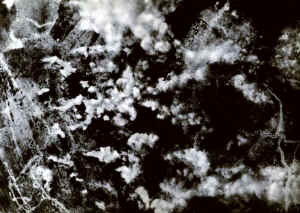 |
| Aerial view of a gas attack |
Poisonous gas grenades again initiate the attack; 63,000
pieces are there to use. However, the attack, which is planned for 7 July,
has to be postponed until 11 July, because of bad weather conditions. At
00:00 hours the bombardment begins, but the poisonous gas has little
effect on the French; they are prepared and are using well working gas
masks. When the German attacking troops get in motion, French fire is so
severe that it creates gigantic confusion: because of the narrow front the
attack troops and reserve troops get mixed up without co-ordination. One
of the battalion Commanders of the 3d Regiment Jäger, refuses
to continue the attack: it would lead to useless blood shattering among
the inexperienced newcomers in his battalion.
Yet there is one success to report: Fleury is eventually completely
occupied by the Germans. Fort Souville is situated at a distance of 500
metres.
The occupiers of Fleury are waiting for the reserve troops that
will have to come from Fort Douaumont, so that a breakthrough to Verdun
can be made.
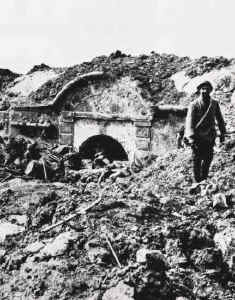 |
| Fort Souville at the end of 1916 |
The reserve troops do not appear and neither do the supplies;
there is an immense lack of ammunition, food and drink. French
reinforcements do appear after a short period of time on the Belville hill
crest and they immediately deploy field artillery, aimed at Fleury, which
forces the Germans into hiding.
The German attack on the left wing fails. The German troops are fired at
with such force that they cannot leave Fort Vaux. After a bombardment that
lasts for 8 hours there is an interlude. Only half of the turned out
troops reach Batterie de Damloup. The target, the Laufée-fortification,
is not reached but along the way a few smaller fortifications are taken
anyway.
In stead of breaking through the gap in the defence near Fleury to reach
Verdun, the German army leaders decide to launch an attack on Fort Souville, where a lost French company coincidentally reinforced the
Garrison.
(Note: from 1 July onwards the fort is fired at on a daily basis by
the Germans; the total of the fired grenades in this period is supposed to
be more than 38,000.)
Wednesday - 12 July The order to attack Fort Souville is given.
There are only two companies of the 140th Regiment Infantry
available to launch the attack.
Driven by their own artillery fire, which
does not reach far enough, only a few German soldiers manage to reach the fort;
even the upper side of the fort is taken. They see Verdun in the distance
but no reinforcements appear and eventually the French overpower them.
Again the German attack on Verdun has failed.
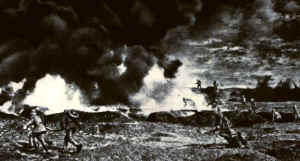 |
| German
flame-thrower attack |
This day General Nivelle gives a moving order of the day, in which the
French troops are praised for their perseverance and their persistency. He
concludes with the famous sentence: 'Ils ne passeront pas!'
['They will
never pass']
|
Louis Barthas describes such
an flame-thrower attack:
...At my feet two unlucky creatures rolled the floor in misery.
Their clothes and hands, their entire bodies were on fire. They were
living torches... [The next day] ... In front of us on the floor the
two I had witnessed ablaze, lay rattling. They were so
unrecognisably mutilated that we could not decide on their
identities. Their skin was black entirely. One of them died that
same night. In a fit of insanity the other hummed a tune from his
childhood, talked to his wife and his mother and spoke of his
village. Tears were in our eyes... (Louis
Barthas - Les carnets de guerre de Louis Barthas, tonnelier,
1914-1918) |
|
From 12 July onwards General Falkenhayn tells the Vth army that
a period of quiet at the front must follow. The conquered lines have to be
defended, even against heavy counterattacks. The assignment is given to
economise on ammunitions. Troops and artillery are still being transferred
to the Somme front and to the eastern front.
The battle at the Verdun front still continues,
albeit on a smaller scale, and is mainly concentrated around the
fortifications and armed bunkers that belong to the originally French
defence system around Verdun. Here heavy fighting occurs daily, which
causes the front line to differ from day to day.
Saturday - 15 July General Mangin launches an even larger
attack on Fleury. The 37th African division is deployed in this
attack but does not succeed in taking the village. Again this is a hasty
attack without artillery back up and the French losses are enormous again.
 The third German attack: the Battle for Fleury
The third German attack: the Battle for Fleury
The German army commanders decide to attack one more time in
order to consolidate the front between Fleury and the
Thiaumont-fortification.
Tuesday - 1 August The attack takes place. The German left wing
almost reaches Fort Tavannes but they have no success on the right wing.
Until Saturday 12 August the battle goes back and forth. The Thiaumont-fortification is conquered and re-conquered several times. On this day the
fortification is back in German hands.
In the German headquarters in Stenay it is now considered to cease the
Verdun offensive altogether. There are no more prospects for any victory:
there is a shortage of artillery and ammunition. Also there are no more
reserve troops available and the front troops are completely exhausted.
Nevertheless the battle continues: the area between Fort Souville and the
Froideterre-fortification is one large muddy field with shell-holes where
French and Germans take turns in attacking and counterattacking.
|
A German soldier: … you could never get rid of the horrible stench. If we
were on leave and we were having a drink somewhere, it would only last a
minute before the people at the table beside us would stand up and leave.
It was impossible to endure the horrible stench of Verdun... |
|
The
battlefield is covered with dead bodies and wounded men; there is nothing
even remotely resembling a front-line. On both sides the troops live in
beastly circumstances. There is an enormous shortage of drinking water,
ammunitions and food. Once again the losses are huge.
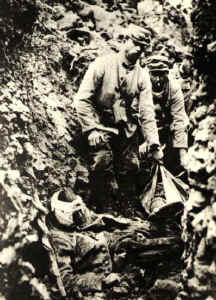 |
| A French trench after an attack |
Thursday - 17 August The French attack again, without result, near the
Fleury and Thiaumont-fortification. On Sunday 3 September the Germans make
a small progress in gaining ground in the area of the Nez de Souville but
on Wednesday 6 September the French launch a counterattack and the old
front line is restored once again.

 Read
about the explosion in the Tavannes Tunnel Read
about the explosion in the Tavannes Tunnel
From 6 September it becomes (temporarily) quiet on the battlefield of
Verdun.
|







